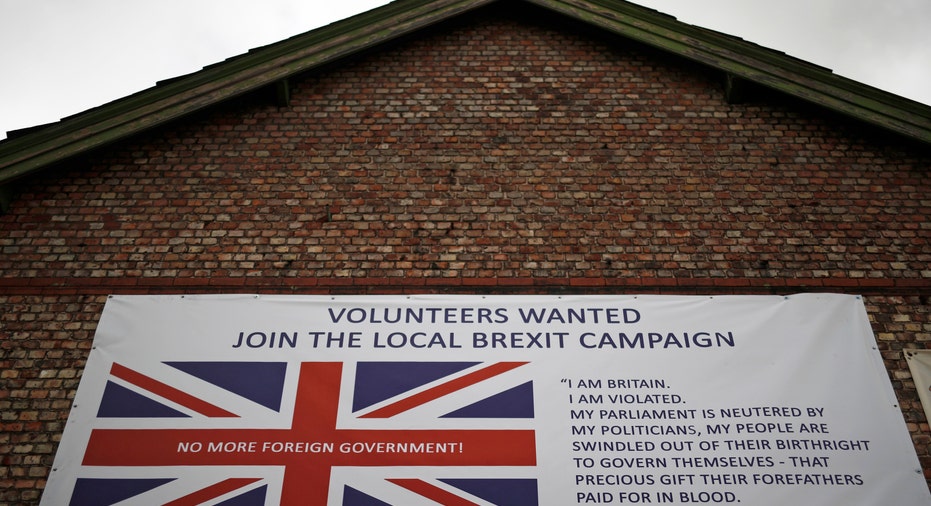Wall Street Braces for Brexit

U.S. equity markets treaded water during Friday’s session, but a look under the hood showed just how concerned investors across the world are ahead of a key vote in Britain next week. The so-called Brexit referendum on Thursday will allow the U.K to decide whether to maintain its membership in the European Union, or sever it.
U.S. stocks capped the final trading day of the week on a relatively muted note as traders looked ahead to next week and digested unexpectedly dovish comments from St. Louis Federal Reserve President James Bullard. The Dow shed 59 points, or 0.33% to 17674, while the S&P 500 declined 6 points, or 0.33% to 2071, and the Nasdaq Composite fell 44 points, or 0.92% to 4800.
On a week-to-date basis, however, the major averages saw steeper losses. The Dow posted declines of 1.07%, while the S&P 500 declined 1.18%, and the Nasdaq dropped 2.98%.
The S&P 500’s financial sector was one of week’s worst performers, shedding nearly 2% as concerns mount about how global banks will weather a potential “leave†vote in the U.K. Should voters decide to exit the EU, banks will have to consider whether to move their physical presence from London to another city within the EU in order to continue doing business with nations in the bloc.
Meanwhile, the telecom and utilities sectors were the only sectors finishing the week in positive territory, climbing 1.37% and 0.67%, respectively.
As investors ditched their more risky positions in U.S. equities, they favored traditionally safe bets including gold and Treasury bonds. Gold prices rose 1.5% for the week, ending at $1,292 a troy ounce, and extending two-straight weeks of gains to three. On Thursday, prices topped the psychologically-significant $1,300 level before falling back slightly. The precious metal has seen a 6.4% jump in prices since the start of the month, and is up more than 21% for the year.
Elsewhere, bond yields across the world continued their descent. In the U.S., the yield on the 10-year U.S. Treasury bond, down for three-consecutive weeks, declined 0.022 percentage points this week to 1.616%. Yields move in the opposite direction of prices.
Still, despite the overall cautious sentiment that played out in global markets early in the week, Dennis DeBusschere, senior managing director at Evercore ISI, said in a note that investor risk appetites are still elevated. He cited Friday’s rebound in both Asian and European markets, and the muted tone in the U.S. as evidence.
“Brexit fears have pushed equity markets lower, but that trend has started to reverse. Slow growth is here to stay, according to the Fed’s SEP, and that should translate into a higher average level of volatility going forward,†he said.
Further, he said despite U.K. sentiment polls showing favor toward a “leave†vote, the odds have declined. The bottom line: He said with slower economic growth, there’s less room for equity markets to absorb economic shocks and shifts in investor sentiment, so investors should expect volatility to remain elevated.
“If the U.K. remains in the EU, volatility is likely to subside, helping to lift equity valuations. That being said, it is important to keep in mind that the current level of implied equity volatility is what we investors should expect to be the norm unless growth accelerates,†he said.
A number of events and data releases on next week’s calendar are sure to keep investors on their toes, especially with the Brexit vote on the horizon at the end of the week.
On Tuesday and Wednesday, Federal Reserve Chief Janet Yellen will present monetary-policy testimony in front of the Senate Banking and House Financial Services Committees. Investors will keep a keen ear to her remarks for any changes in her stance on the future path for interest-rate hikes in the U.S. On Wednesday of this week, the Fed’s policy-setting arm, the Federal Open Market Committee, opted to keep rates steady, citing the May jobs report, low levels of inflation, and the looming Brexit vote.
“We expect Yellen to reiterate the cautious message of [this] week’s post-FOMC meeting press conference. However, we cannot discount the risk that she will deliver a slightly more upbeat message in case she is dissatisfied with the financial market’s interpretation of the path of monetary policy,†economists at Deutsche Bank noted.
Also on the economic-data calendar in the U.S. is existing and new home sales figures, weekly jobless claims, durable goods orders, and a final read on consumer sentiment in June.
IHS Global Insight U.S. Economists Kristin Reynolds and Manoo Sabety-Javid said they expect to see a pick up in the pace of existing home sales in May, though they warned the pace of growth in new home sales likely moderated last month after April registered as the fastest pace in eight years.